9 Reasons Why Your Snake Plant Is Not Growing(+What To Do)
The snake plant keeps on taking everything you give them with grace without any complaints. But if the condition remains unfavorable for a longer period, your snake plant’s growth will be affected. So, if your snake plant is not growing, you need to look into their care routine.
Overwatering and root rot is the primary cause of stunted growth in a snake plant. Apart from that, under fertilizing, low light, repotting, humidity, and pest problems are a common problem that can affect your snake plant’s growth. Keep up with the care routine and water your snake plant when the soil gets dry.
Snake plants are nearly indestructible and are ideal container plants. They can be grown in any conditions and still stand stiff and green.
Snake plants that are suffering could be due to extreme conditions you have kept them in.
We want you to know more about your snake plant, likes and dislikes and fix them to see new growth again.

Please note: Simplify Plants is reader-supported. Some links in the post are affiliate links and I get a commission from purchases made through links in the post.
How fast does snake plant grow?
A snake plant can grow 2-4 inches in a month. The growth of the plant will vary depending upon the variety you choose. It will also differ depending upon the humidity level, lighting, and watering, and nutrients provided.
However, not everyone has success with this amazing plant. Some people struggle to grow their snake plant.
And if you are one of them, then don’t worry, you are not alone. In this article, we shall discuss all about growing a healthy and bushy snake plant.
My snake plant is not growing
It is a serious issue when you do not see any growth in your snake plants. Snake plants are not easily stressed.
There must be something wrong you are doing for a prolonged period that is affecting their growth.
Let us get the right know-how about snake plant growth-related issues.
Snake plant not getting enough light

Snake plants will do fine in low light, but the growth might suffer. The right amount of light will help in the consistent growth of your snake plant.
Light helps to convert water, light, and oxygen into carbohydrates. It converts nutrients into energy. They dry out the soil and help the soil to function efficiently.
Snake plants can withstand direct sun too, but they will grow huge if you give them indirect bright light.
The three factors you need to look for while choosing the right spot for your snake plant are:
- The amount of light
- The intensity of light
- Spectrum
They need to be balanced for the ideal growth of the snake plant. They might be lacking light to produce ample energy to shoot new growth.
Light is crucial to have glossy green leaves in the snake plant. Due to low light, your plant is suffering, and you need to fix that by moving them to a better and brighter spot.
Also read: How much light do snake plant need?
Snake plant humidity level is not ideal

Hailing from West Africa, many snake plant parents think they need high humidity. It isn’t true.
Being succulents, snake plants thrive at a humidity level of about 40-50% Room temperature in which you would thrive, your snake plants will thrive too.
The snake plant is a sturdy houseplant, but it may still suffer if you consistently keep them in an inadequate humidity level. 40-50% humidity is not too low, not too high, and can be said to be on the average side.
Humidity is the amount of water vapor present in the air. This should be relatively low as compared to other moisture-loving houseplants.
If the humidity level goes too high, the chances are your snake plants are suffering due to this condition. At the same time, if the conditions are arid, your snake plant will likely as well. Although some variety of snake plant can tolerate a wide range of humidity levels.
Also read: Where should I keep my snake plant?
Growing at the wrong time of the year
A snake plant can take rest during dormant periods. What we mean by that is during autumn through winter, most houseplants, including the snake plant, will rest and stay healthy. They don’t show much growth during this time of the year.
This period is from October to February, when you might hardly see your snake plant growing.
If your snake plant was growing initially in the growing season and suddenly stopped in the dormancy period, then the growth has temporarily stopped due to environmental changes.
This is a normal tendency. If they have been taken care of rightly in the growing seasons, then they will stay healthy during this period with minimal care.
Another reason is light as the light intensity reduces during winters, the plant will not be able to produce enough energy needed for their growth.
Snake plant not getting enough water

Snake plants like to be on the drier side. Sometimes they go beyond the point due to which your snake plant suffers to grow. Yes, they can go exceptionally long without a drink, but someday they will need water to work with ease.
There are several factors concerning the watering needs of the snake plant. If the cultural conditions such as temperature, lighting, and humidity are on point, then your snake plant needs water once every two weeks.
They can go without water up until six weeks, which is excellent. This can again vary if the cultural conditions are not ideal.
Snake plants adjust themselves to a variety of conditions and even thrive when conditions are adverse. Though sometimes, they can suffer due to quick shifts in the environment.
Underwatered snake plants can be identified through droopy, yellow, and wilting foliage. The leaves lose their shine and firmness.
Let us say your snake plant is living in high-temperature levels and getting a lot of suns all day long; then, they might need water more frequently.
However, one snake plant’s needs may vary from another depending on different environmental conditions.
Though overwatering is a killer snake plant, if you are on the overfeeding side, then watch out.
They will not tolerate overwatering and can suffer due to it. Yes, they will stop growing in such conditions too.
Also Read: How Much Water Does A Snake Plant Need?
Snake plant not getting enough nutrients

Snake plants are not needy ones; they are tough ones. Hobbyists generally don’t feed their snake plant or just give a topping of compost on the soil. This usually works for a snake plant.
There are chances that compost is not fulfilling your snake plants’ nutrients needs due to which they are not growing. Nutrients are required to produce energy to have new growth. Plant use light to convert energy into food.
For snake plants lacking nutrients, feed them with an all-purpose houseplant fertilizer. It will balance all the lacking nutrients in the soil.
Do not fertilize during the autumn and winter season as the plant is in resting mode and will not use the nutrients. These nutrients will accumulate as salt buildups in the soil.
Also read: Do snake plant like coffee grounds?
Growing snake plant in wrong type of soil
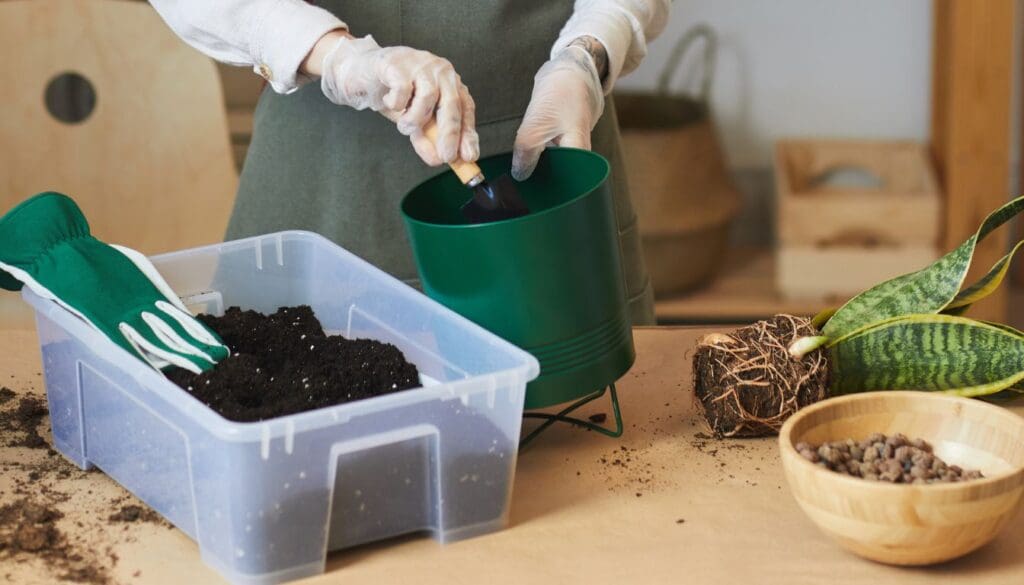
Growing snake plants in the wrong type of soil is a big no. The reason being these plants are easily susceptible to root rot. This can affect their growth as well as lead to the death of the snake plant.
The stems, root, and foliage of your snake plant reserve water and are susceptible to root rot easily. The soil mix needs to be aerated to work properly.
Chances are the potting mix is heavy and poorly draining. It is not allowing oxygenation and water flow in the soil and roots. The main problem would be soil in the potting mix of your snake plant. It sounds crazy yet fact.
Beginners usually make this mistake of using soil in a potting mix of snake plants. Also, those using garden soil, please stop!
Wrong or inappropriate soil mix will affect the health and growth of the snake plant. It will not allow air and water to flow, leading to soggy soil and roots. It is the fastest way to kill your snake plant.
Also read: What type of soil is good for snake plant?
Repotting again and again
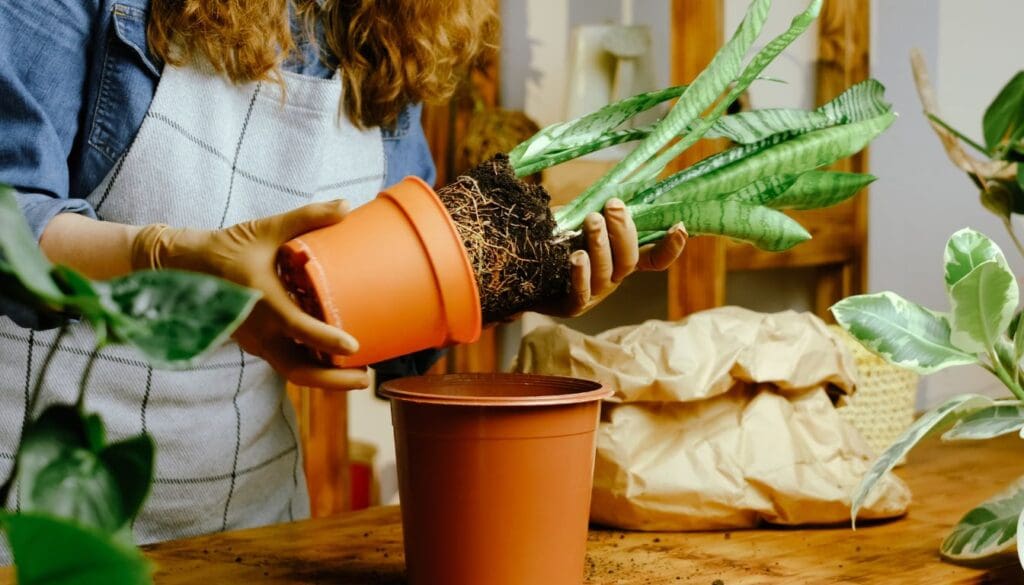
Snake plants with good health and healthy growth can be propagated by repotting. Some impatient people tend to repot their snake plant after every sign of distress.
Yes, a stressed snake plant might need repotting, but if you stay patient and give them the required caring, you can revive your dull plant into life without repotting at all.
Repotting, again and again, will stress and disturb the growth of your snake plant. The roots become weak and support fungal growth.
If your snake plant has stopped growing after you have repotted them, then it’s because of repotting.
Just because you saw yellow or brown leaves, fungal infection, etc., you cannot just repot and expect them to grow like before. A lot of things change, and they need more care after repotting.
If you repot your snake plant when you see roots developing out to the drainage holes, hold onto it till they grow extensively.
If you are repotting every time you see roots, you are slowly exterminating your snake plant. The snake plant likes to stay in small pots as they have a shallow root structure and takes time to stabilize their roots.
Pests infestation on snake plant
Snake plants are not readily susceptible to pests, but poor care schedules can attract pests. They can certainly kill your snake plant. They are such tiny bodied insects that you might not know that your snake plant is suffering.
Your snake plant will tell you through several signs that they are infested with pests such as:
- Yellow leaves
- Brown leaves
- Deformed leaves
- Brown and black spots on leaves and stems
- Discoloration
- Brown, white spots on leaves
- No new growth
- Distorted leaves and stem
The snake plant becomes weak due to pest infestation. These pests suck the plants feeding all the nutrients in the plant, making them weak. The plant will not be able to carry out essential processes and produce energy to grow.
This leads to the issues mentioned above and then stunted growth. Check under the leaves where these pests reside the most. Control them as soon as you discover them.
Your snake plant is stressed
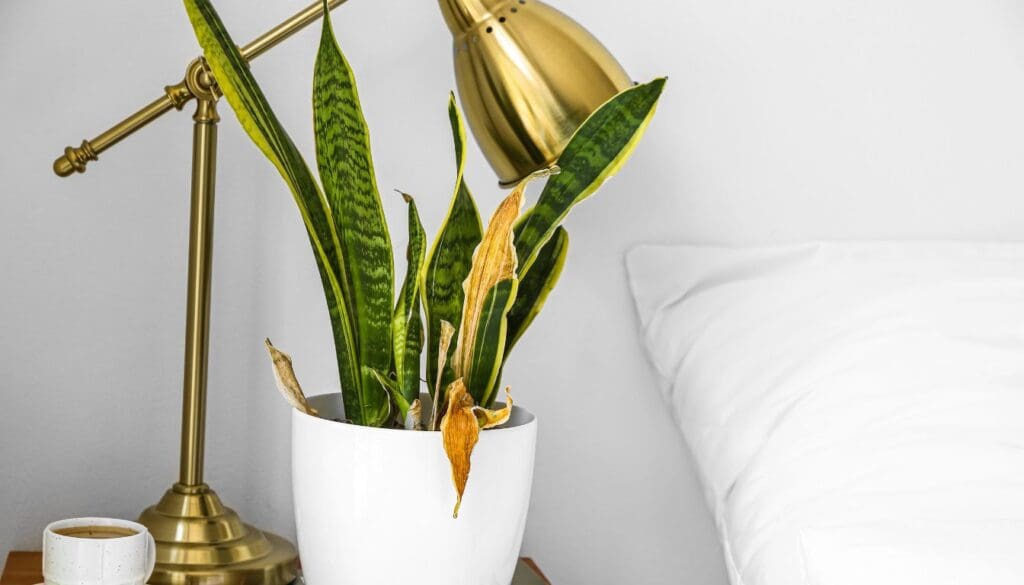
The snake plant gets into stress, mostly due to environmental shifts. The leaves turn brown, yellow, or droop, showing stress due to temperature shifts or humidity change. It could be due to over or under watering, over-fertilizing, or even lighting issues.
Overwatered snake plants may even die. They suffocate the soil and roots due to which oxygen and water flow will block.
It will affect the water and airflow in the leaves and stem and dehydrate them. Thus, the leaves will turn yellow.
Underwatering stresses snake plants, causing droopy, brown, and yellow leaves. The leaves become dull and lifeless.
When you fertilize inadequately, your snake plant will show signs of distress through brown spots on leaves, yellow leaves, or brown leaves and stunted growth.
These signs are the beginning of a stressed snake plant and lead to bigger problems like yellowing leaves and wilting.
How can I make my snake plant grow faster?
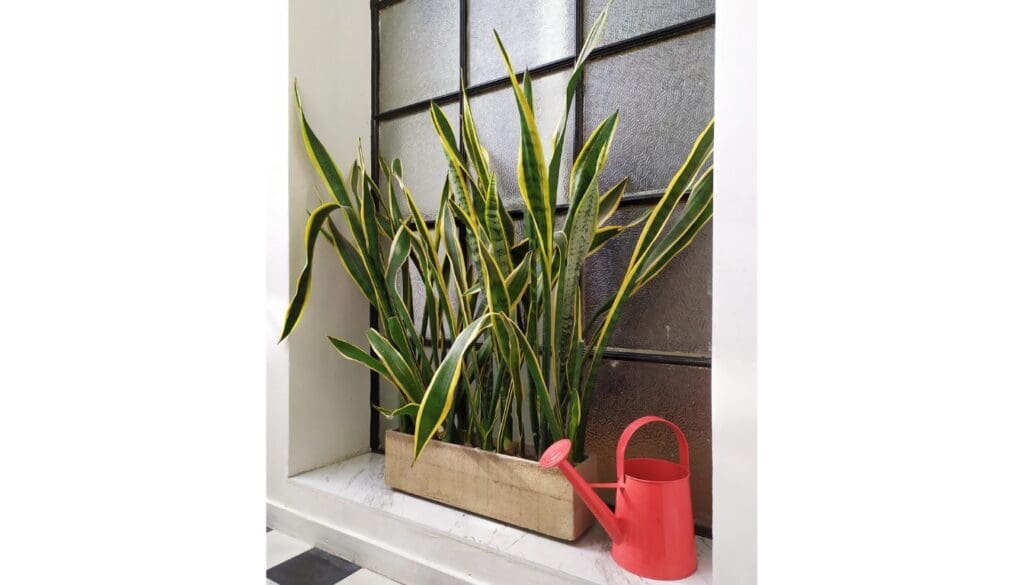
To encourage your snake plant’s healthy and bushy growth, you need to provide them with adequate care and environment.
To encourage your snake plant’s healthy and bushy growth, you need to provide them with adequate care and environment.
By maintaining the ideal temperature, you can keep the humidity level the snake plant needs.
During the daytime, if the temperature level is between 60 degrees Fahrenheit to 80 degrees Fahrenheit and at night between 55 degrees Fahrenheit to 70 degrees Fahrenheit, then you can keep up with the ideal humidity too.
Maintain ideal humidity level and see your snake plant green and healthy. If you feel the humidity level is beyond 80%, then you can use a dehumidifier to maintain the needed humidity.
However, most variety of snake plant does well in a wide range of humidity. But some of them do suffer.
Also Read:
Watering
The best and most convenient method is using your finger. Dig your finger in the soil from the top to check the moisture in the soil.
If you see soil sticking in your finger, that indicates moist soil. Check again after a few days and water when the soil seems dry.
While watering your snake plants, make sure the excess water has drained out of the soil. Never water your snake plant’s leaves as that will lead to leaf rot and other related issues.
Light
Ideally, the west or south-facing window is perfect for your snake plant placement. Also, keep in mind that they shouldn’t be getting direct sun near the window.
In that case, move your snake plant about 8-10 feet away from the window. This will give them enough light to grow without giving them any scar too. This will fulfill their light requirement.
Grow lights also help to provide sufficient light to your snake plant. Just monitor the intensity and amount of light your snake plant is getting all day long.
The snake plant likes to stay dry rather than drowning in water. They should be planted in a well-draining and well-aerated soil mix to support them. The soil mix we recommend is:
- 3/4 of organic potting soil. (I usually go with Miracle Grow Indoor potting mix)
- 1/4 of organic succulent & cactus mix.
- A few handfuls of organic compost.
- Worm Compost (for topping ½” layer on the top of the soil)
You can buy soil mix formulated for succulents from the market or make yours at home.
Fertilizer

Fertilize your snake plant once a month during growing periods. Avoid fertilizing in the dormant time of the year. All-purpose houseplant fertilizers are best suited for snake plants.
Also, a water snake plant after fertilizing them as water will help the soil and roots to absorb fertilizer properly. Give them proper light too. After fertilizing, you need to take proper care of snake plants; otherwise, they will over saturate as salt in the soil.
Also Read: Does Snake Plant Need Fertilizer? (What Type, How Much & More)
Pests
Separate your infested snake plant to avoid other plants from getting contaminated.
Prune any infected parts of your snake plant, if any. Wash the entire plant thoroughly under running water. You can add dishwashing soap (without bleach) to remove stubborn pests.
There are a few ways to control pests infestation:
- 1tsp dishwasher soap + 1 liter of water
- 1 tsp neem oil = 1-liter water
- Sprinkle cinnamon powder on the plant
- Spray permethrin, derris, or malathion containing products
- 3-in-1 insecticide/fungicide/miticide
Repeat any of the above-given treatment once a week till your snake plant shows visible relief.
After your plant has recovered, you can bring them to their previous location and make sure to give extra care to them and keep inspecting them. Prick bugs if you see any with your hands.
Also Read: Do Snake Plants Attract Bugs? (+How To Deal With Them)
Repotting
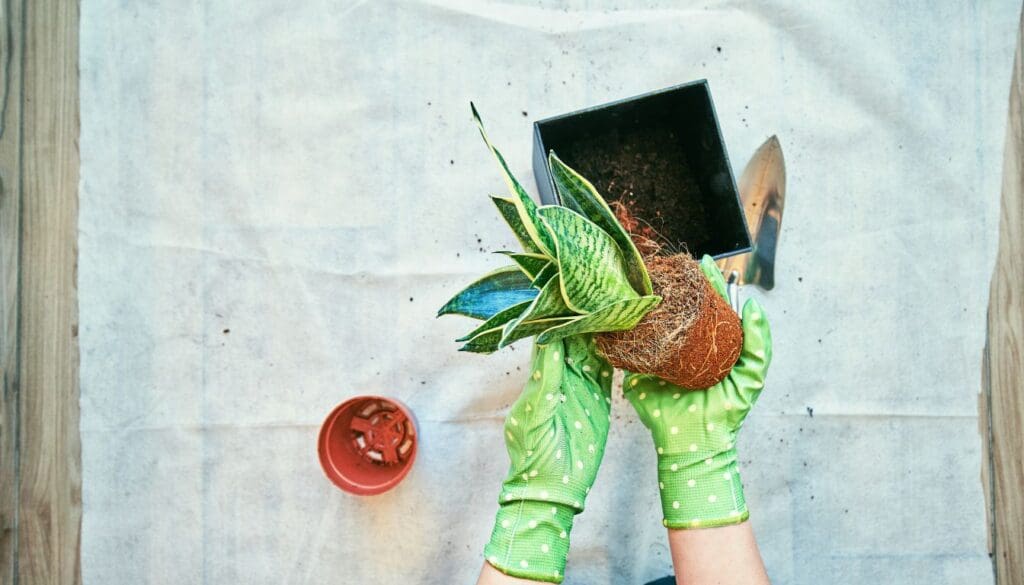
Do not rush in case of repotting your snake plant. The rhizomes and roots are hardy ones and like to be pot bound. They should not be stressed with repotting due to minor issues.
With patience, everything can be worked out, so can your snake plant will. Snake plants when getting brown leaves; just by correcting your watering routines, you will see them becoming healthier in no time.
Keep in mind, repotting a snake plant should be done with at least two years gap. If the problem is severe, start with treating other possible measures. If you still find your snake plant suffering and have no other option left than only go for repotting.
Stressed snake plant
Stressed snake plants, as we discussed earlier, are generally due to environmental shifts. They can be corrected by monitoring what the cause of their stress is.
Just monitor and provide them with ideal cultural conditions along with the right resources. You will soon see your snake plant healthy and growing.

Recommended Garden Supplies
| Product Image | Our Recommended Gardening Supplies | Check Offers! |
|---|---|---|
Top Top
Top
Top
Top
Top
Top
Top
Top | rePotme Houseplant and Tropical Classic Potting Soil Mix | Check Offer On Amazon |
 Top
Top
Top
Top
Top
Top
Top
Top | Espoma Organic Indoor Plant Food | Check Offer On Amazon |
 Top
Top
Top
Top
Top
Top
Top
Top | GooingTop LED Grow Light 6000K Full Spectrum Clip Plant Growing Lamp | Check Offer On Amazon |
 Top
Top
Top
Top
Top
Top
Top
Top | Soil Moisture Meter | Check Offer On Amazon |
 Top
Top
Top
Top
Top
Top
Top
Top | Govee Hygrometer Thermometer, Bluetooth Enabled! | Check Offer On Amazon |
 Top
Top | LEVOIT Humidifiers for Large Room(Best For Plants) | Check Offer On Amazon |
 Top
Top
Top
Top
Top
Top
Top
Top | Upgraded DIY Automatic Drip Irrigation Kit, 15 Potted Houseplants Support | Check Offer On Amazon |
 Top
Top
Top
Top
Top
Top
Top
Top | Stainless Steel Heavy Duty Gardening Tool Set | Check Offer On Amazon |
 Top
Top
Top
Top
Top
Top
Top
Top | Bonide Insecticidal Soap | Check Offer On Amazon |
 Top
Top
Top
Top
Top
Top
Top
Top | Bonide 32 oz Spray Neem Oil for Organic Gardening | Check Offer On Amazon |
 Top
Top
Top
Top
Top
Top
Top
Top | Garden Safe Fungicide | Check Offer On Amazon |

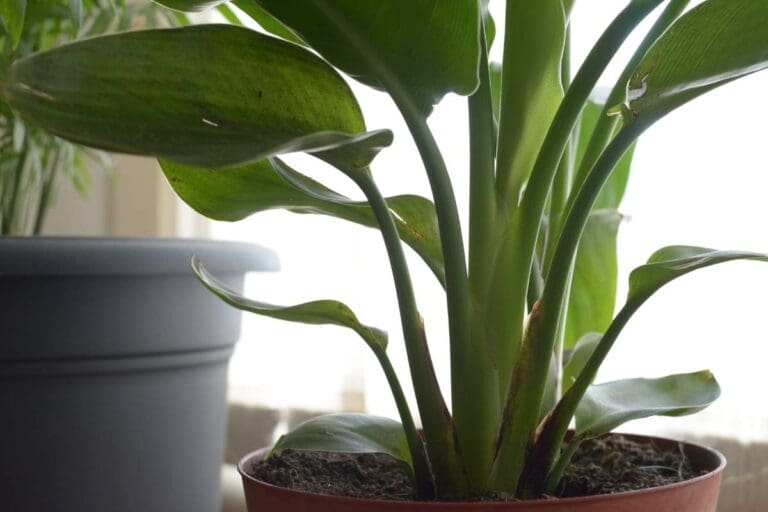
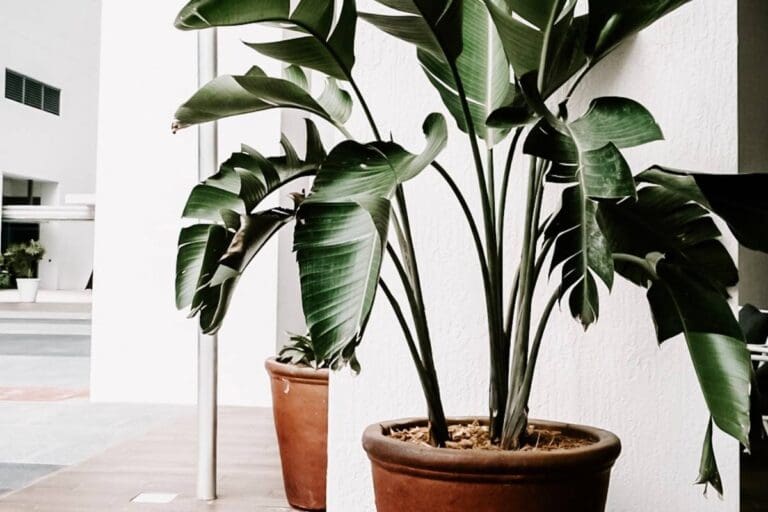
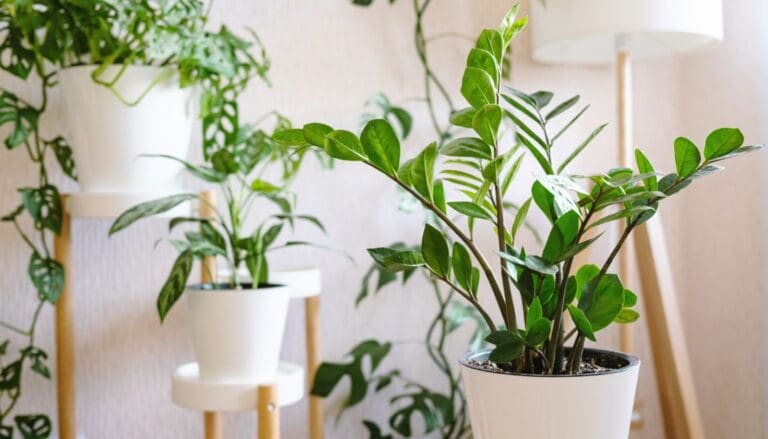
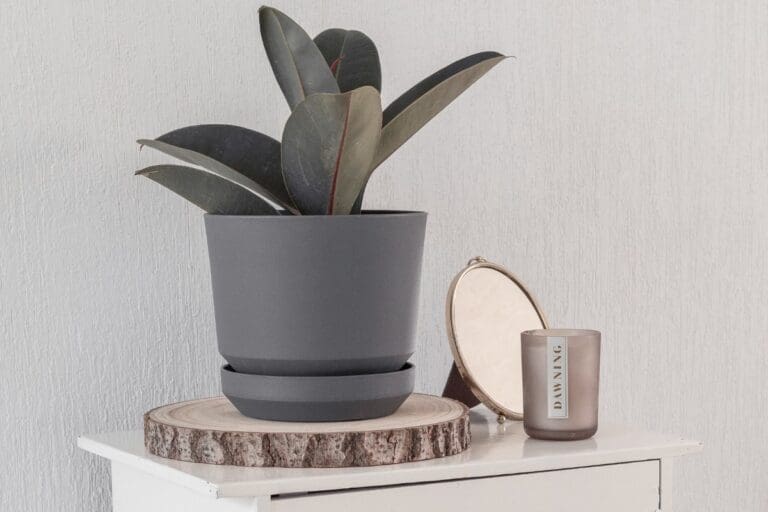
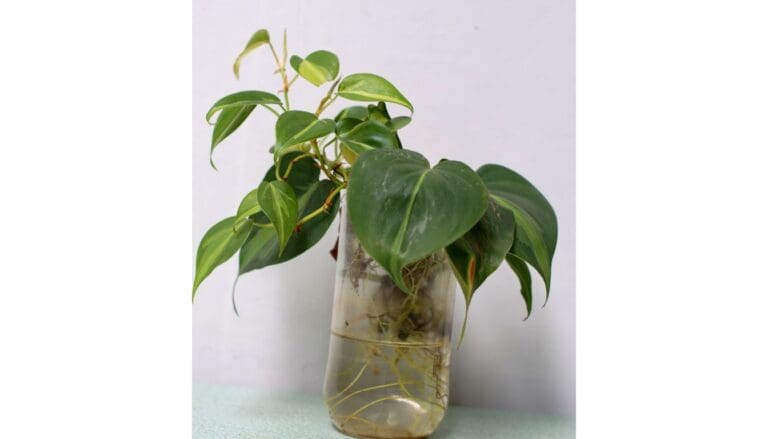

I need help with my snake plant 😳🙁
Please share the details and we will try to help!
I water my snake plant from the bottom is that ok??
Hey Judy,
Watering a snake plant from the bottom is perfectly fine and can be beneficial as it encourages the roots to grow downward and helps prevent overwatering. Just make sure the plant is able to absorb the water it needs and that the pot is allowed to drain any excess to avoid waterlogging.
Is snake plant good for bedroom.
Hey tony,
Yes, snake plants are great for bedrooms! They improve air quality by converting CO2 to oxygen at night and are low-maintenance, thriving in low light conditions.
I have several snake plants that are falling over in the soil. I have to prop them up with rocks. What should I do? I made the soil mixture recommended for succulents.
Falling snake plants may indicate they need a deeper pot or more stable soil. Ensure the pot is deep enough to support their height and consider adding a bit more soil around the base for stability. Avoid overwatering, as this can weaken the roots. Maybe you could share the picture in our facebook group for more insight.
I must have the weirdest snake plant ever! The plants were not doing well in the pot and several died. One had worked its way out of the soil (well draining succulent mix) so out if desperation i put it in a narrow necked vase in water. Since then it is thriving and growing like crazy. Should i switch to hydroponics for the rest of the plants in the pot?
Not weird at all—some snake plants really thrive in water! If your plant is happy in the vase, you can definitely try moving the others to water as well. Just make sure to keep the water clean and change it every couple of weeks. Hydroponics can be a great option for snake plants, especially if they’re struggling in soil.